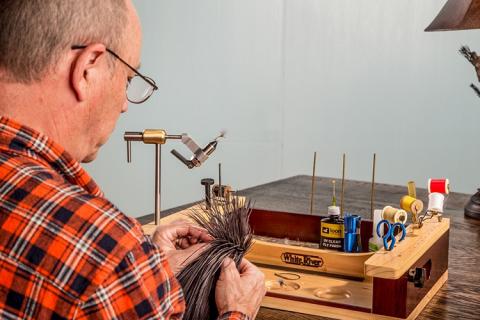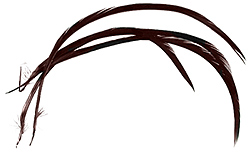
One of the most interesting and unique materials to ever grace a fly has to be the biot feather. This one-of-a-kind material is actually a single feather barb from the lead edge of a primary wing feather from a large bird such as a goose or turkey. On the feather shaft biots are hard to tell from one another seeing as they lay flat on top of one another. Biots are small, sharply-pointed fibers that allow the creative tier to realistically simulate legs or gnarly looking appendages on bottom dwelling imitations.
 |
| Biots are specialty feathers often used by fly tiers to create life-like appendages. |
Specific Biot Types
In general, goose biots are the most used by tiers simply due to the fact that they are relatively easy to find, cheap and a good size for most nymph patterns. Turkey biots are the next major type of biot available, and they are relatively larger and stiffer than goose biots, even though both birds are very similar in size. Both these two types of biot feathers take to the dying process very well, allowing tiers to color-match patterns to the respective natural near exact. Biots can also be died in exuberant attractor-type colors that demand a fish's attention. If you have never tried incorporating biots into your favorite fly patterns, goose or turkey biots are great for experimenting. These two types of feathers are relatively large and easy to handle for those not used to handling biots, and biots are not overly brittle, cracking with the first sign of excessive pressure.
For the inquisitive tier, other types of biots can be used such as duck biots, which are smaller and more delicate. Another commonly used biot would have to be that of a ring-neck hen pheasant, which is very similar in size and flexibility to duck biots. Softer biots are great for simulating legs, antennae or tails on your favorite bugs as they provide life-like action in swift-water currents.
If you plan on going out and purchasing a few biots, always be sure to look over the fibers and ensure that they will be long enough for your pattern. Each package of biots will vary from another, so fingering the fibers a little guarantees they meet your requirements. Additionally, with dyed biots, check the feathers to make sure the entire biot has been dyed adequately. In some cases the outside of the biot will take up the dye while the center or stalk will remain white or not dyed. These variegated biot feathers can still be used on flies, with little loss in productivity from fish but will definitely detract from the look of your flies. If you are looking for a unique look for your bug's body, try tying in a natural wild turkey biot and see how the mottled appearance of the feathers create a two-tone, segmented look for the body.
Preparation is Key
Before actually tying flies with biot feathers, fly tiers need to situate themselves for success. First and foremost, get a little practice tying biots down to the hook shank and wrapping the fibers to create tight segmented bodies. Nothing is worse then getting half way through your fly and starting to create the biot body and not being able to handle the feather easily. If you are not careful and confident with your hands and hackle pliers you can kink or tear the biot, ruining all your hard work.
If you are going to be tying in biots for spent wings, being able to confidently wrap the feathers into position on the top of the hook shank will save you much frustration. A good idea is to match the biots you want to use (by size, length and color) before you begin tying your flies to get the best results. A quick soak in warm water will help soften larger goose or turkey biots for wrapping tight segmented bodies.
Tying With Biots
Biot feathers have many different uses in flies, but the techniques used to get the desired result from the feathers differ greatly. One good point to remember is that each biot is slightly curved, so deciding ahead of time what you want from the look of the feather should dictate how it will be tied to the hook shank.
Segmented Bodies: To create realistic-looking bodies is simple with biots, but first you have to figure out whether you want a smooth looking abdomen or a segmented look. How you tie the tip of the biot to the hook shank (curving up or down) effects how the body will look. It you tie the biots with an upward curvature, as you wrap the feather up the hook shank, the tailing edge of the biots will stand up, creating segmentation as you wrap forward. If you tie the biot in tip first, with the curvature down, the resulting wrapped body will be smooth and even.
Tails and Antennae: To create biot tails or antennae on flies, the only thing tiers have to take into consideration is to make sure both biots curve the same way. For tails that curve up and out, simply pinch both the fibers together between your thumb and for-finger and place them on top of the hook shank. A few simple wraps of thread and a half hitch or two is all that is needed now to hold things in place.
To create biot tails that curve downward, a slightly different technique is used. First, apply a small amount of dubbing to the thread and build a ball of dubbing about half the hook eye in diameter at the point where you want the tail to be placed. Grasp the biots (both curving the same way) and measure for length. Place these two biots on the top of the hook shank just in front of the ball of dubbing and place a loose turn of thread at the point where the biots begin to separate. Apply increasing pressure to the thread, twisting the tail into position while flaring the biots. Add a few more turns of thread to the biots to hold them in place securely.
Realistic Legs: To create realistic-looking legs for your flies, two methods can be used to shape the biots into the desired position. First, if you are nimble-fingered, you can knot the biot fibers, creating a hinged look for the leg. If you are having trouble knotting these fine feathers, there is another approach to making realistic looking legs. Simply kinking the biots in the desired location with a pair of flat-nosed tweezers and treating the affected area with liquid head cement will hold the legs in a life-like walking position.
Goose and turkey biots are a specialty type of feather that many fly tiers — even those with a wealth of knowledge in materials and tying techniques — do not incorporate enough into their respective patterns. Biots are very simple to use, and the look they give patterns is spectacular. Realistic-looking naturals and flashy-looking attractor patterns can be made with biot feathers without ever having the need for any of the new space-age synthetics.
- 10522 views

